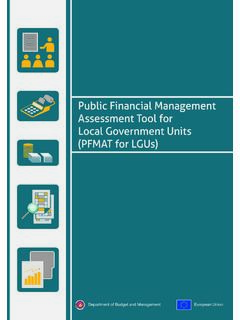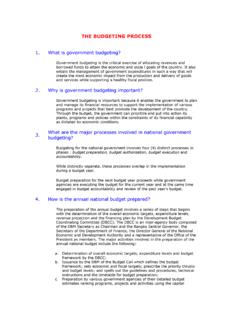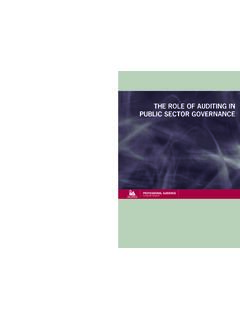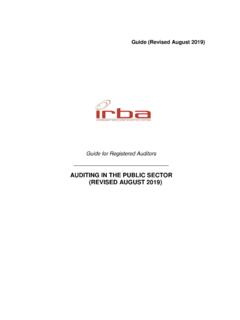Transcription of CHAPTER ONE CHAPTER ONE
1 NATIONAL GUIDELINES ON internal CONTROL SYSTEMS 1 CHAPTER ONECHAPTER ONECHAPTER ONECHAPTER ONE INTRODUCTION NATIONAL GUIDELINES ON internal CONTROL SYSTEMS 2 OBJECTIVES OF THE NGICS The National Guidelines on internal Control Systems (NGICS) is an initiative taken by the national government to affirm its commitment to the citizenry towards accountability, effective operations, prudence in finances, and quality service. It unifies in one document existing Philippine laws, rules and regulations on internal controls to serve as a benchmark towards designing, installing, implementing and monitoring internal controls in the public service. The NGICS contains the fundamental principles, policies and general standards that will guide each government agency in developing its detailed and comprehensive system of internal controls.
2 Agency characteristics such as mandate, functions, nature of activities, operating environment, manpower profile, size and organizational structure will have to be considered in developing or improving the individual controls. A strong and responsive internal control system (ICS) is an essential component of an organization s internal and external processes. It can significantly enhance the integrity of operations and improve organizational outcomes and results to achieve sectoral goals. The benefits of an internal control system include: Stronger accountability; Ethical, economical, efficient and effective operations; Improved ability to address risks to achieve general control objectives; Better systems of responding to the needs of citizens; and Quality outputs and outcomes and effective governance.
3 In essence, the NGICS aims to update and further broaden public sector understanding of internal control processes to sharpen agency capacity in their development, implementation, monitoring and evaluation. LEGAL BASES FOR internal CONTROL The installation, implementation and strengthening of internal control systems in the Philippine bureaucracy has been mandated under the 1987 Philippine constitution , existing laws, and administrative rules and regulations. The concepts and principles outlined in various legislative acts and administrative issuances are complemented by best NATIONAL GUIDELINES ON internal CONTROL SYSTEMS 3 practices and guidelines issued by the Commission on audit (COA) and various international organizations, such as the International Organization for Standardization (ISO) and the International Organization of Supreme audit Institutions (INTOSAI), of which the Philippines is a member.
4 The primary legal bases for internal controls in the Philippines are: a) Section 123 of Presidential Decree (PD) 1445 dated June 11, 1978, as amended (Ordaining and Instituting a Government Auditing Code of the Philippines), which defines internal control as the plan of organization and all the coordinate methods and measures adopted within an organization or agency to safeguard its assets, check the accuracy and reliability of its accounting data, and encourage adherence to prescribed managerial policies. b) Section 124 of PD 1445, as amended, which states that [i]t shall be the direct responsibility of the agency head to install, implement, and monitor a sound system of internal control. c) Section 2(1), Article IX-D (Commission on audit ) of the 1987 constitution , which provides that where the internal control system of the audited agencies is inadequate, the Commission may adopt such measures, including temporary or special pre- audit , as are necessary and appropriate to correct the deficiencies.
5 D) Section 1, CHAPTER 1, Subtitle B, Book V of the Administrative Code of 1987, which provides that [a]ll resources of the government shall be managed, expended or utilized in accordance with law and regulations and safeguarded against loss or wastage through illegal or improper disposition to ensure efficiency, economy and effectiveness in the operations of government. The responsibility to take care that such policy is faithfully adhered to rests directly with the chief or head of the government agency concerned. e) Section 1 of Administrative Order No. 119 dated March 29, 1989 (Directing the Strengthening of the internal Control Systems of Government Offices, Agencies, Government-owned or Controlled Corporations and Local Government Units in their Fiscal Operations), which states that [t]he responsibility for the fiscal operations of offices and agencies NATIONAL GUIDELINES ON internal CONTROL SYSTEMS 4 of government is hereby declared to reside primarily with the respective Heads of each office, agency, government-owned or controlled corporation and local government unit.
6 For this purpose, each and every office, agency, corporation, and local government unit is mandated to strengthen its internal control system and/or organize systems and procedures to that effect in coordination with the Department of Budget and Management. f) Memorandum Order No. 277 dated January 19, 1990, which directs the Department of Budget and Management to promulgate the necessary rules, regulations or circulars for the strengthening of the internal control systems of government offices, agencies, government-owned or controlled corporations and local government units, in the implementation of AO 119; Provided, That said rules, regulations or circulars shall not be interpreted to diminish the powers and functions of the Commission on audit as set by the constitution and by law, including its power to adopt necessary and appropriate measures to correct deficiencies where the internal control system of the audited agencies is inadequate.
7 G) Article 9, Public Procurement and Management of Public Finances, CHAPTER II, Preventive Measures, of the United Nations Convention against Corruption (UNCAC), which states that: 2. Each State Party shall, in accordance with the fundamental principles of its legal system, take appropriate measures to promote transparency and accountability in the management of public finances. Such measures shall encompass, inter alia: (a) Procedures for the adoption of the national budget; (b) Timely reporting on revenue and expenditure; (c) A system of accounting and auditing standards and related oversight; (d) Effective and efficient systems of risk management and internal control; and (e) Where appropriate, corrective action in the case of failure to comply with the requirements established in this paragraph.
8 NATIONAL GUIDELINES ON internal CONTROL SYSTEMS 5 METHODOLOGY FOR THE NGICS FORMULATION A generic set of guidelines on internal control (IC) is necessary. The Department of Budget and Management (DBM), in collaboration with the Office of the President internal audit Office, initiated the preparation of the NGICS. The process entailed the organization of a Reference Panel and Resource Agencies to which the draft NGICS was presented for comments in a series of meetings. The DBM chaired the meetings of the Reference Panel and Resource Agencies. The members of the Panel came from the Department of Education (DepEd), Department of Finance (DOF), Department of Health (DOH), Department of the Interior and Local Government (DILG), Department of Public Works and Highways (DPWH), Department of Transportation and Communications (DOTC), National Economic and Development Authority (NEDA), and Development Academy of the Philippines (DAP).
9 The Resource Agencies were the Commission on audit (COA) and the Presidential Anti-Graft Commission (PAGC). The NGICS will be issued as a general guidance document for all government agencies. It will be piloted in two agencies, the DPWH and the DepEd, where a detailed plan of organization, methods and measures, and systems and processes will be installed to comprise the respective agency internal controls. NATIONAL GUIDELINES ON internal CONTROL SYSTEMS 6 CHAPTER TWOCHAPTER TWOCHAPTER TWOCHAPTER TWO CONCEPT OF internal CONTROLCONCEPT OF internal CONTROLCONCEPT OF internal CONTROLCONCEPT OF internal CONTROL NATIONAL GUIDELINES ON internal CONTROL SYSTEMS 7 DEFINITIONS OF internal CONTROL internal control refers to the plan of organization and all the coordinated methods and measures adopted within an organization or agency to safeguard its assets, check the accuracy and reliability of its accounting data, and encourage adherence to prescribed managerial policies (Section 123 of Presidential Decree No.)
10 1445, as amended). This legal definition is supplemented by the policy that [a]ll resources of the government shall be managed, expended or utilized in accordance with law and regulations and safeguarded against loss or wastage through illegal or improper disposition to ensure efficiency, economy and effectiveness in the operations of government. The responsibility to take care that such policy is faithfully adhered to, rests directly with the chief or head of the government agency concerned (Section 1, CHAPTER 1, Subtitle B, Book V of the Administrative Code of 1987). The definition of internal control is amplified in the COA Government Accounting and Auditing Manual (GAAM) Volume III which states that internal control comprises the plan of organization and all the methods and measures adopted within an agency to ensure that resources are used consistent with laws, regulations and policies; resources are safeguarded against loss, wastage and misuse; financial and non-financial information are reliable, accurate and timely; and operations are economical, efficient and effective (Section 32, Title 2, Volume III of the GAAM).
















